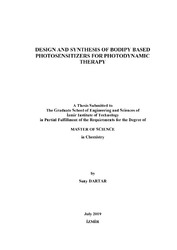Please use this identifier to cite or link to this item:
https://hdl.handle.net/11147/7498Full metadata record
| DC Field | Value | Language |
|---|---|---|
| dc.contributor.advisor | Emrullahoğlu, Mustafa | |
| dc.contributor.author | Dartar, Suay | - |
| dc.date.accessioned | 2019-12-18T10:50:25Z | |
| dc.date.available | 2019-12-18T10:50:25Z | |
| dc.date.issued | 2019-07 | en_US |
| dc.identifier.citation | Dartar, S. (2019). Desing and synthesis of BODIPY based photosensitizers for photodynamic therapy. Unpublished master's thesis, İzmir Institute of Technology, İzmir, Turkey | en_US |
| dc.identifier.uri | https://hdl.handle.net/11147/7498 | |
| dc.description | Thesis (Master)--Izmir Institute of Technology, Chemistry, Izmir, 2019 | en_US |
| dc.description | Includes bibliographical references (leaves: 33-36) | en_US |
| dc.description | Text in English; Abstract: Turkish and English | en_US |
| dc.description.abstract | Photodynamic therapy is a promising modality for the non-invasive treatment of several cancerous and non-cancerous diseases. PDT is more preferable than other therapies due to its low damage to non-targeted tissues and its controllable characteristics. The therapy involves the activation of a photosensitizer under light illumination to generate singlet oxygen which is the cytotoxic agent employed against the cancerous tissues. Thus, there is currently a great effort to develop various photosensitizers. Among these, BODIPY based photosensitizers are distinguished due to certain characteristics, including excellent photostability, high extinction coefficients and high resistance to photobleaching. In this study, we aimed to synthesize and develop new BODIPY based photosensitizers for the use of photodynamic therapy agents. BODIPY skeleton was devised using the dibromoethylene unit from the 2,6-positions in order to enhance the π-conjugation system for red shift to longer wavelengths resulting in a deep penetration of tissue. Heavy atoms such as bromine were introduced to the BODIPY core to ensure the transition from singlet states to triplet states via intersystem crossing for the generation of singlet oxygen. Photophysical properties and spectroscopic measurements of photosensitizers were performed successfully. Finally the photodynamic activities of photosensitizers in cancerous cells were also investigated. | en_US |
| dc.format.extent | x, 40 leaves | en_US |
| dc.language.iso | en | en_US |
| dc.publisher | Izmir Institute of Technology | en_US |
| dc.rights | info:eu-repo/semantics/openAccess | en_US |
| dc.subject | BODIPY | en_US |
| dc.subject | Photodynamic therapy | en_US |
| dc.subject | Cancer cells | en_US |
| dc.title | Desing and synthesis of BODIPY based photosensitizers for photodynamic therapy | en_US |
| dc.title.alternative | Fotodinamik terapi için BODIPY bazlı ışık duyarlaştırıcıların tasarımı ve sentezi | en_US |
| dc.type | Master Thesis | en_US |
| dc.institutionauthor | Dartar, Suay | - |
| dc.department | Thesis (Master)--İzmir Institute of Technology, Chemistry | en_US |
| dc.relation.publicationcategory | Tez | en_US |
| local.message.claim | 2022-06-13T11:13:16.105+0300|||rp03032|||submit_approve|||dc_contributor_author|||None | * |
| item.languageiso639-1 | en | - |
| item.fulltext | With Fulltext | - |
| item.openairecristype | http://purl.org/coar/resource_type/c_18cf | - |
| item.openairetype | Master Thesis | - |
| item.grantfulltext | open | - |
| item.cerifentitytype | Publications | - |
| crisitem.author.dept | 04.01. Department of Chemistry | - |
| Appears in Collections: | Master Degree / Yüksek Lisans Tezleri | |
Files in This Item:
| File | Description | Size | Format | |
|---|---|---|---|---|
| T002029.pdf | MasterThesis | 2.19 MB | Adobe PDF |  View/Open |
CORE Recommender
Page view(s)
34,562
checked on Jul 22, 2024
Download(s)
342
checked on Jul 22, 2024
Google ScholarTM
Check
Items in GCRIS Repository are protected by copyright, with all rights reserved, unless otherwise indicated.